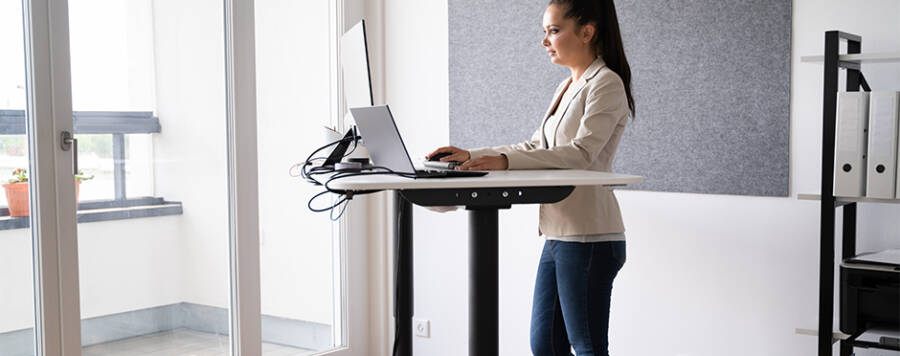Benefits of a Standing Desk
1. Standing can lower your risk of weight gain and obesity
Standing instead of sitting can burn more calories. A study showed standing for the same amount of time as sitting doing sedentary work burned an additional 170 calories.2 Now, this might not seem like much, but over five workdays, that can be almost an additional 1,000 calories burned.
2. Standing desks may reduce back pain
Back pain is a common complaint of office workers who sit all day. A study showed up to 32% improvement in low back pain after several weeks of using standing desks.3 Another study by the CDC found that sit-to-stand desks reduced upper back and neck pain by up to 54% in just four weeks.4
3. Standing desks may help improve mood and energy levels
Sedentary work or sitting may have links to increased risk of depression and anxiety. In turn, standing desks had participants reporting less stress and increased energy.4
What about a Treadmill Desk?
If standing is better than sitting, then walking would be better than just standing, right? Answer: Maybe.
Treadmill desks are also becoming popular. Walking at a slower pace, no more than two mph is recommended not to be distracted from your work; a slower pace can also limit the amount of fatigue or sweat you experience. Treadmill desks are not meant to be for a full 8-hour day; start by aiming for 30-minute increments and a maximum of three hours per shift. The benefits of a treadmill desk are like those of a standing desk – decreased back pain, decreased heart issues, improved weight loss, and increased productivity.5 Treadmill desks are quite costly, though, and take up a lot of room.
The Correct Way to Stand at a Desk
- Your spine should be in a straight line
- Your elbows should be at a 90-degree angle when your wrists are flat on the desk
- Your monitor should be at eye level
- You should alternate sitting and standing throughout the day if that is an option
- Do not lock your knees when standing; keep a slight bend
- If you find that you tend to stand with weight shifted onto one side, try getting a short stool to rest your opposite foot on; you can alternate which foot is on the stool and which is on the floor
A standing desk is not a replacement for regular exercise. The American Heart Association still recommends that adults get 30 minutes of physical activity five days/week.6
Choose Physical Therapy
If you are currently experiencing pain or need assistance getting more exercise throughout your day, physical therapy is a great place to start. Schedule a Free Assessment with one of our movement experts today. Free Assessments are available in-clinic and virtually through our Telehealth platform.
The Athletico blog is an educational resource written by Athletico employees. Athletico bloggers are licensed professionals who abide by the code of ethics outlined by their respective professional associations. The content published in blog posts represents the opinion of the individual author based on their expertise and experience. The content provided in this blog is for informational purposes only, does not constitute medical advice and should not be relied on for making personal health decisions.
References:
1. Biswas A, Oh PI, Faulkner GE, Bajaj RR, Silver MA, Mitchell MS, Alter DA. Sedentary time and its association with risk for disease incidence, mortality, and hospitalization in adults: a systematic review and meta-analysis. Ann Intern Med. 2015 Jan 20;162(2):123-32. doi: 10.7326/M14-1651. Erratum in: Ann Intern Med. 2015 Sep 1;163(5):400. PMID: 25599350.
2. Buckley JP, Mellor DD, Morris M, Joseph F. Standing-based office work shows encouraging signs of attenuating post-prandial glycaemic excursion. Occup Environ Med. 2014 Feb;71(2):109-11. doi: 10.1136/oemed-2013-101823. Epub 2013 Dec 2. PMID: 24297826.
3. Thorp AA, Kingwell BA, Owen N, Dunstan DW. Breaking up workplace sitting time with intermittent standing bouts improves fatigue and musculoskeletal discomfort in overweight/obese office workers. Occup Environ Med. 2014 Nov;71(11):765-71. doi: 10.1136/oemed-2014-102348. Epub 2014 Aug 28. PMID: 25168375.
4. Pronk NP, Katz AS, Lowry M, Payfer JR. Reducing occupational sitting time and improving worker health: the Take-a-Stand Project, 2011. Prev Chronic Dis. 2012;9:E154. doi: 10.5888/pcd9.110323. PMID: 23057991; PMCID: PMC3477898.
5. MacEwen BT, MacDonald DJ, Burr JF. A systematic review of standing and treadmill desks in the workplace. Prev Med. 2015 Jan;70:50-8. doi: 10.1016/j.ypmed.2014.11.011. Epub 2014 Nov 28. PMID: 25448843.
6. “How Much Physical Activity Do You Need?” Www.heart.org, https://www.heart.org/en/healthy-living/fitness/fitness-basics/aha-recs-for-physical-activity-infographic.
About the Author:
Tara Hackney, a physical therapist in Marion, IA, enjoys working with all patient types, especially gymnasts, cheerleaders, and dancers. She is the prominent blogger for Athletico's Gymnastic/Cheer Program. With an orthopedic specialization and training in dry needling and Graston technique, Tara hopes to answer your questions about injuries and injury prevention in an easy-to-understand manner. She hopes to ease fears surrounding pain and injuries, address concerns about recovery, and provide tips to prevent injury. In her free time, she enjoys spending time with her dog, reading, and watching her nephews play sports.

 width="900"
height="356"
>
width="900"
height="356"
>

1 Comment
Lauraine Alexis
can anyone tell me how much are the price range of these standing desk?